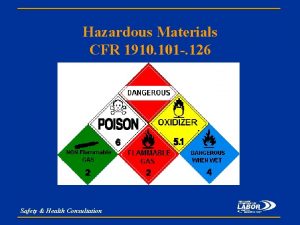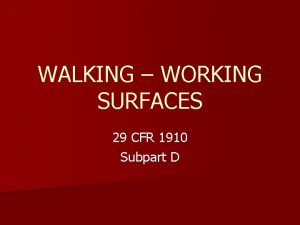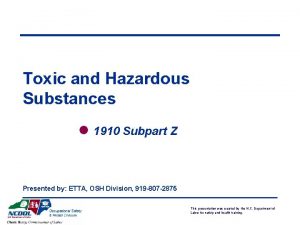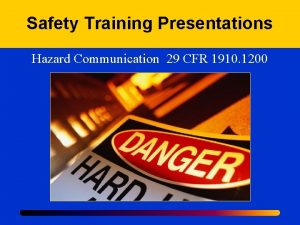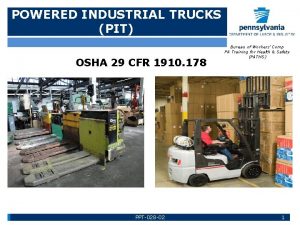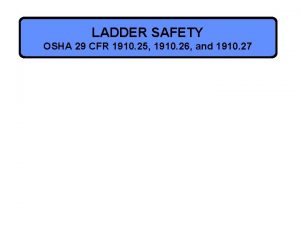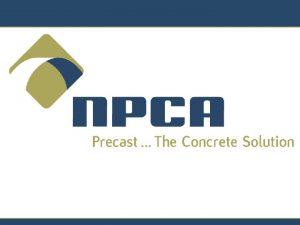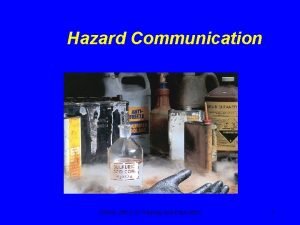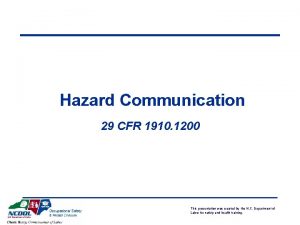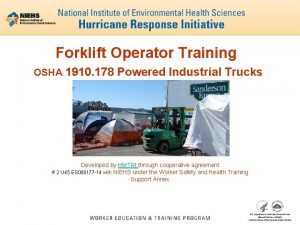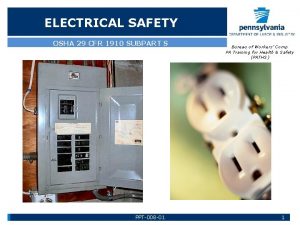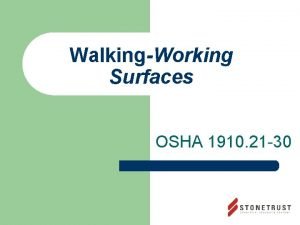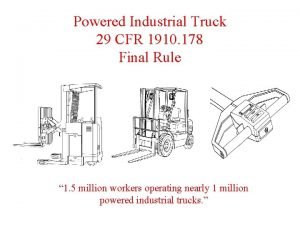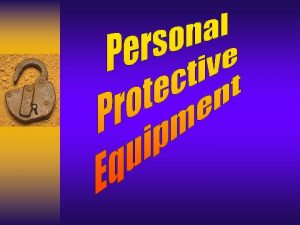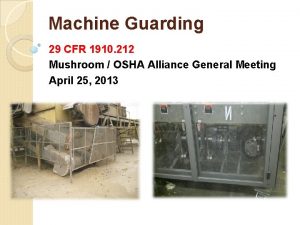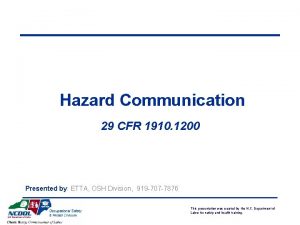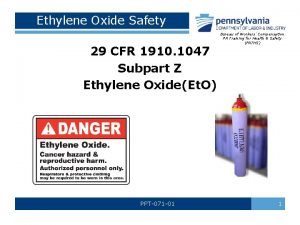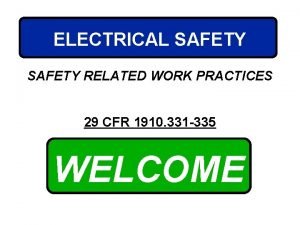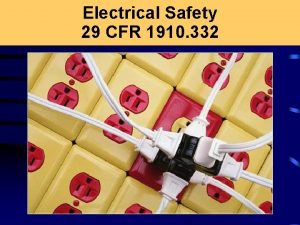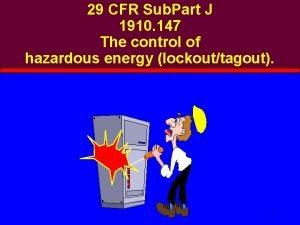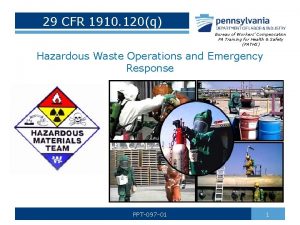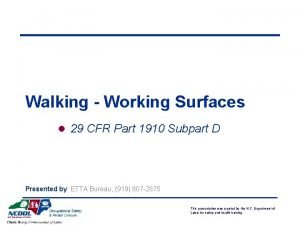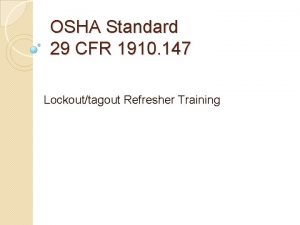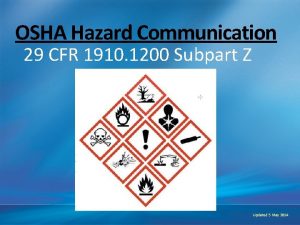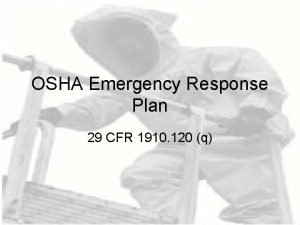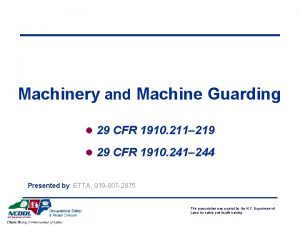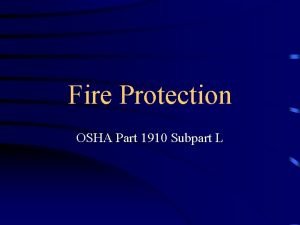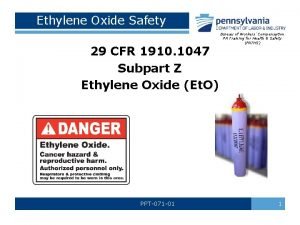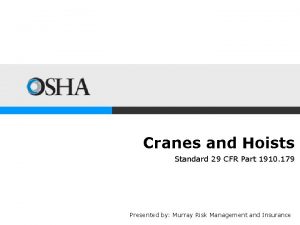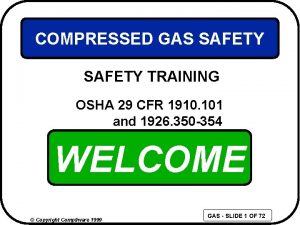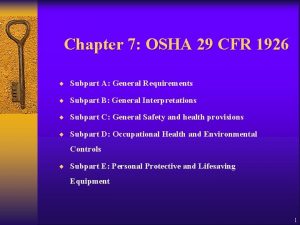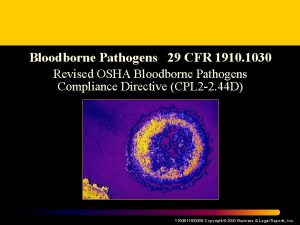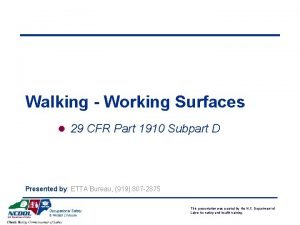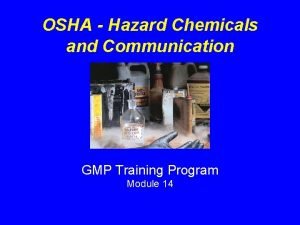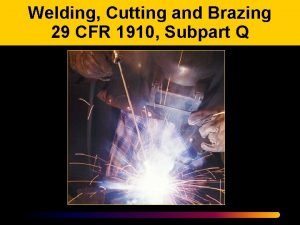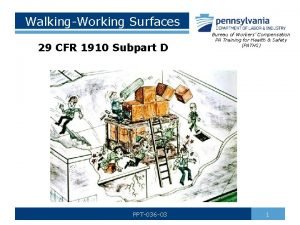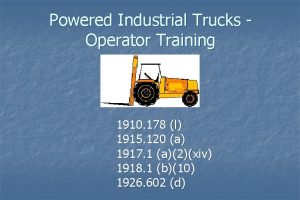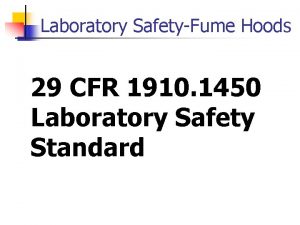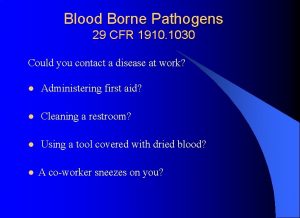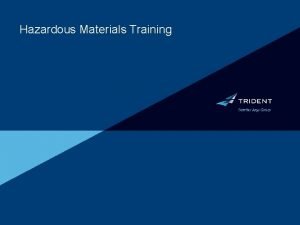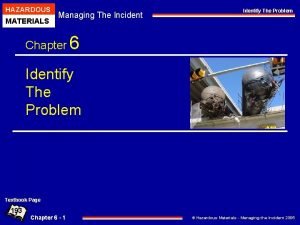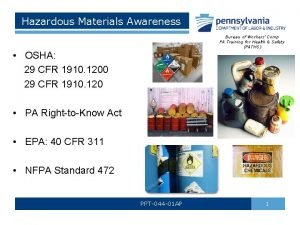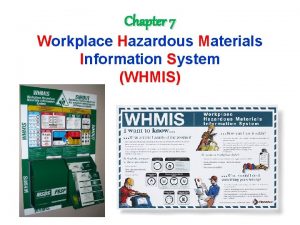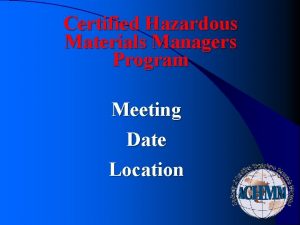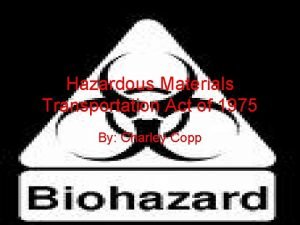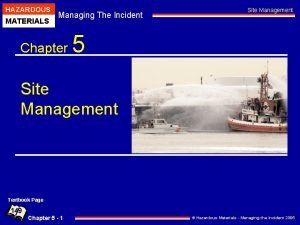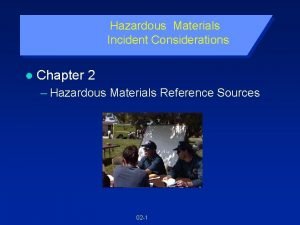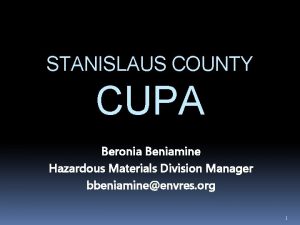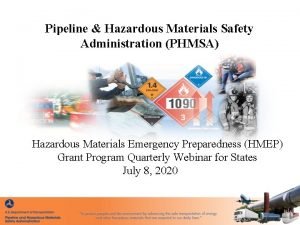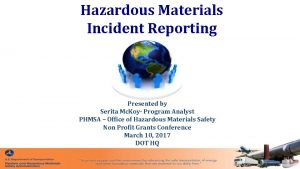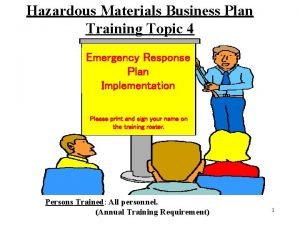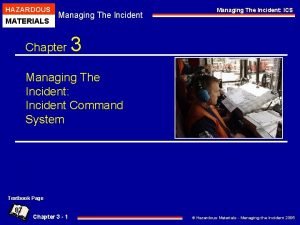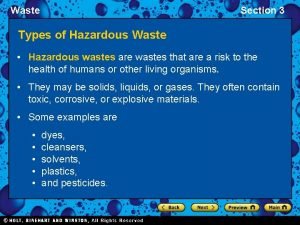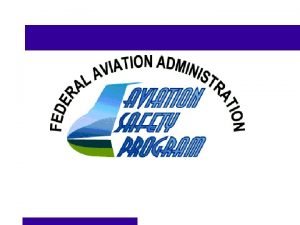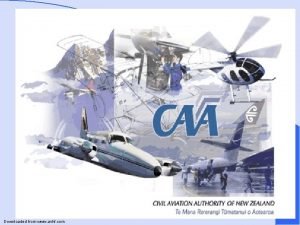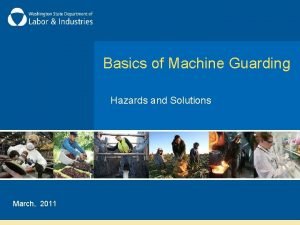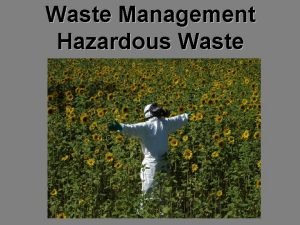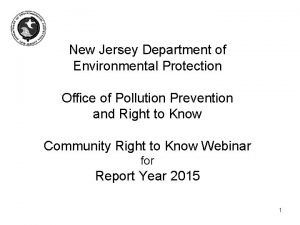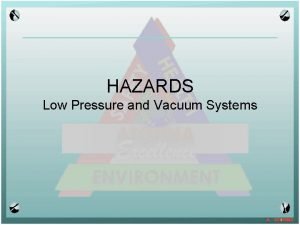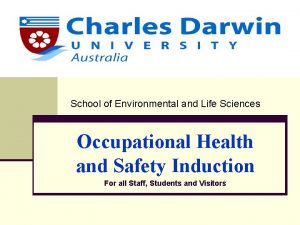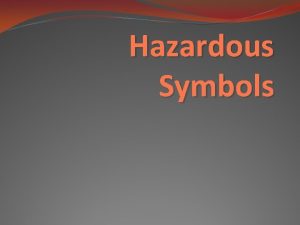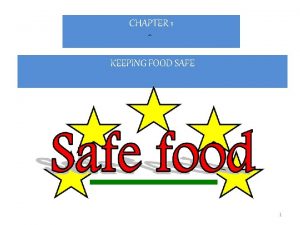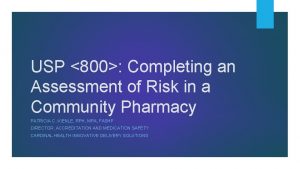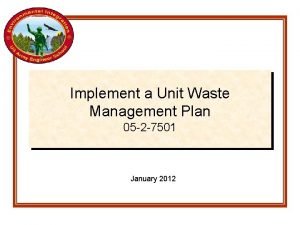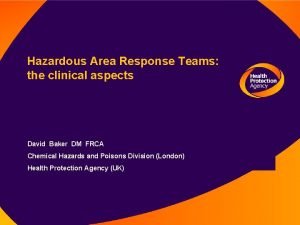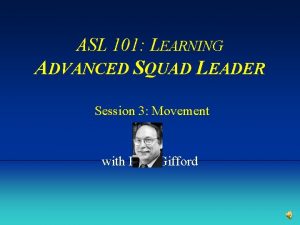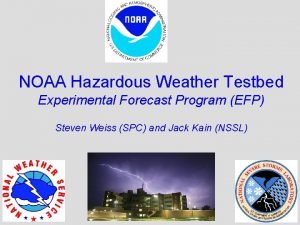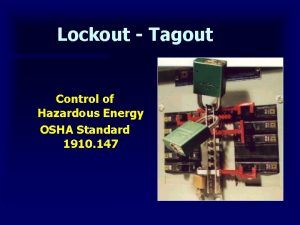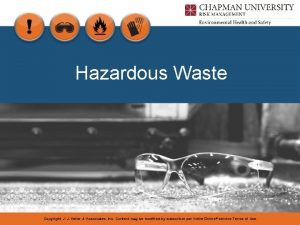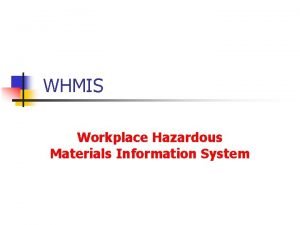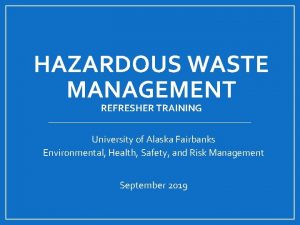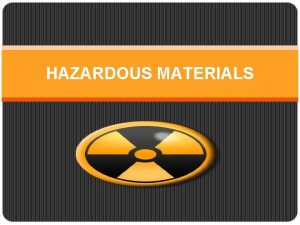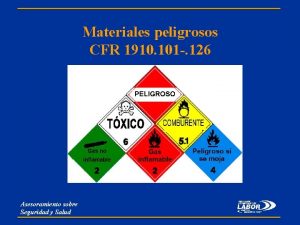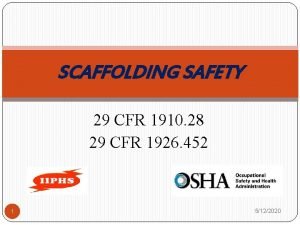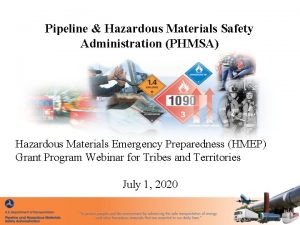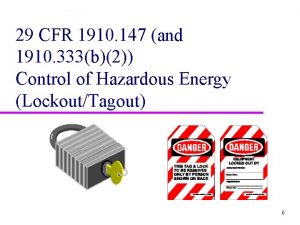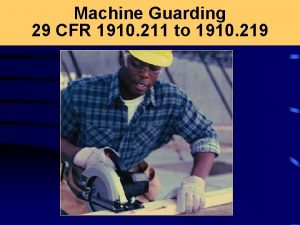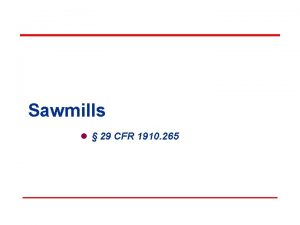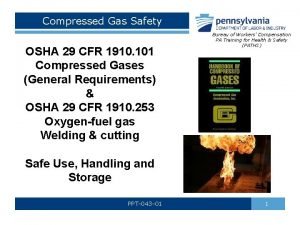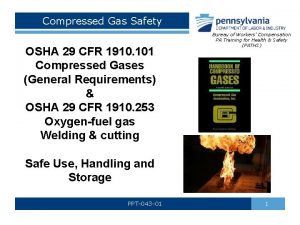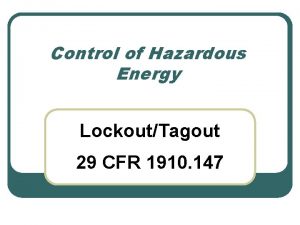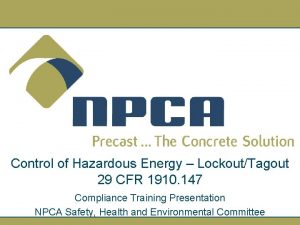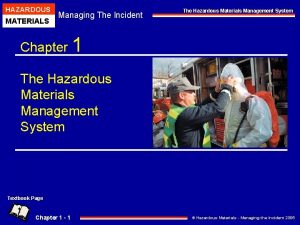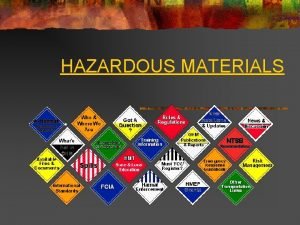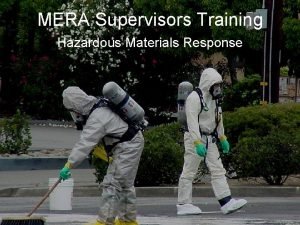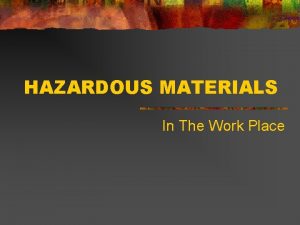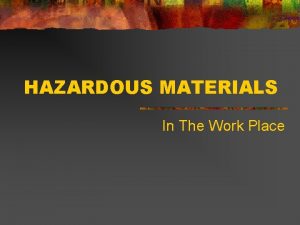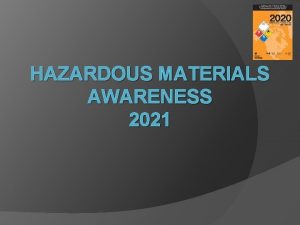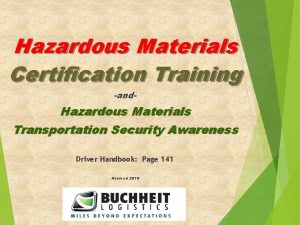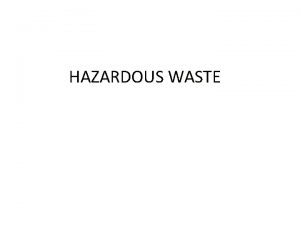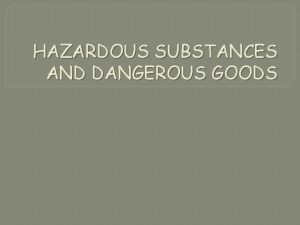Hazardous Materials CFR 1910 101 126 Safety Health

![HAZARDOUS MATERIALS [1910. 101 – 126] 29 CFR 1910 SUBPARTS 101(b) 131 SPRAY BOOTH HAZARDOUS MATERIALS [1910. 101 – 126] 29 CFR 1910 SUBPARTS 101(b) 131 SPRAY BOOTH](https://slidetodoc.com/presentation_image/012a76869e0108fa1bb18372790257e6/image-2.jpg)



















































































- Slides: 85

Hazardous Materials CFR 1910. 101 -. 126 Safety & Health Consultation
![HAZARDOUS MATERIALS 1910 101 126 29 CFR 1910 SUBPARTS 101b 131 SPRAY BOOTH HAZARDOUS MATERIALS [1910. 101 – 126] 29 CFR 1910 SUBPARTS 101(b) 131 SPRAY BOOTH](https://slidetodoc.com/presentation_image/012a76869e0108fa1bb18372790257e6/image-2.jpg)
HAZARDOUS MATERIALS [1910. 101 – 126] 29 CFR 1910 SUBPARTS 101(b) 131 SPRAY BOOTH – AIR VELOCITY 107(b)(5)(i) 66 CLASS I LIQUIDS – DISPENSING 106(e)(6)(ii) 107(b)(5)(iv) 107(g)(2) SUBPART H COMPRESSED GASES – HANDLING STORAGE AND USE 63 SPRAY BOOTH – FILTERS PROTECTED BY SPRINKLERS 58 SPRAY AREAS – CLEANING WITH NON-SPARKING TOOLS 48 2 NUMBER OF SERIOUS VIOLATIONS – FY 2014

Compressed Gases • The in-plant handling, storage, and utilization of all compressed gases in cylinders, portable tanks, rail tank cars, or motor vehicle cargo tanks shall be in accordance with Compressed Gas Association (CGA) Pamphlet P-1 -1965, which is incorporated by reference as specified in 1910. 6 Safety & Health Consultation 1910. 101(b)

Compressed Gas Cylinders • 3. 1. 14, Never tamper with the safety relief devices in valves or cylinders • 3. 1. 15, Never attempt to repair or to alter cylinders, valves, or safety relief devices Safety & Health Consultation CGA Pamphlet P-1 -1965

Compressed Gas Cylinders • 3. 1. 16, Never use cylinders as rollers, supports, or for any other purpose than to contain the contents as received Safety & Health Consultation Big & heav y CGA Pamphlet P-1 -1965

Compressed Gas Cylinders • 3. 1. 17, Keep cylinder valve closed at all times, except when cylinder is in active use • 3. 1. 18, Notify cylinder owner if any condition might have permitted any foreign substance to enter the cylinder or valve: – Provide details of incident – Provide the cylinder serial number Safety & Health Consultation CGA Pamphlet P-1 -1965

Compressed Gas Cylinders • 3. 1. 19, Do not place cylinders where they might become part of an electric circuit • When cylinders are used in conjunction with electric welding, precautions must be taken against accidentally grounding cylinders and allowing them to be burned by electric welding arc Safety & Health Consultation CGA Pamphlet P-1 -1965

Moving Cylinders • 3. 2. 2, Do not lift cylinders by the cap • 3. 2. 3, Never drop cylinders nor permit them to strike against each other or against other surfaces violently Safety & Health Consultation CGA Pamphlet P-1 -1965

Moving Cylinders Lifting magnet • 3. 2. 4, Never handle a cylinder with a lifting magnet • 3. 2. 5, Avoid dragging or sliding cylinders CGA Pamphlet P-1 -1965 Safety & Health Consultation

Moving Cylinders • 3. 2. 6, Use suitable hand truck, fork truck, roll platform or similar device with cylinder firmly secured for transporting and unloading Safety & Health Consultation CGA Pamphlet P-1 -1965 !

Storing Cylinders • 3. 3. 6, Do not store cylinders near highly flammable substances such as oil, gasoline or combustible waste Safety & Health Consultation CGA Pamphlet P-1 -1965

Storing Cylinders • 3. 3. 8, Do not store cylinders near elevators or gangways, or in locations where heavy moving objects may strike or fall on them LP gas stored near exit Safety & Health Consultation CGA Pamphlet P-1 -1965

Withdrawing Cylinder Content • 3. 4. 2, If cylinder content is not identified by marking, return cylinder to the supplier without using I’m not labeled! ! Safety & Health Consultation CGA Pamphlet P-1 -1965

Withdrawing Cylinder Content • 3. 4. 4, Before using a cylinder, be sure it is properly supported to prevent it from being knocked over • 3. 4. 5, Suitable pressure regulating devices must be used Safety & Health Consultation CGA Pamphlet P-1 -1965

Withdrawing Cylinder Content • 3. 4. 6, Never force connections • 3. 4. 7, Where compressed gas cylinders are connected to a manifold, all related equipment, such as regulators, must be of proper design Safety & Health Consultation CGA Pamphlet P-1 -1965

Withdrawing Cylinder Content • 3. 4. 8, Do not mix regulators, gages, hoses and other appliances provided for use with a particular gas or group of gases with incompatible materials/gases Safety & Health Consultation CGA Pamphlet P-1 -1965

Safe Work Practices • 3. 4. 9 – Open cylinder slowly – Point valve opening away from yourself & others – Never use wrenches or tools except those provided by the supplier or approved by the gas manufacturer – Avoid the use of a wrench on a valve equipped with a handwheel Safety & Health Consultation CGA Pamphlet P-1 -1965

Safe Work Practices • 3. 4. 9 – Never hammer on the valve wheel – Frozen, corroded valves; contact the supplier – Use check valves if cylinder is apt to be contaminated by feedback of materials – Before removing a regulator, close the cylinder valve and release all the pressure from the regulator Safety & Health Consultation CGA Pamphlet P-1 -1965

Flammable Gases • 3. 5 – Indoor cylinder storage – Well protected – Well insulated – Dry – Twenty (20) feet from flammable or combustible materials Safety & Health Consultation CGA Pamphlet P-1 -1965

Flammable Gases • 3. 5. 1, Do not store cylinders near highly flammable solvents, combustible waste material and similar substances, or near unprotected electrical connections, gas flames or other sources of ignition • 3. 5. 2, Never use a flame to detect flammable gas leaks; use soapy water Safety & Health Consultation CGA Pamphlet P-1 -1965

Poison Gases • 3. 6. 1, Personnel handling and using poison gases should have available for immediate use gas masks or self-contained breathing apparatus approved by U. S. Bureau of Mines* for the particular service desired • *NOTE: This approval for respirators has been up-dated to the requirements of NIOSH (CGA P-1 2000) Safety & Health Consultation CGA Pamphlet P-1 -1965

Acetylene • Cylinders: In-plant transfer, handling, storage, and utilization of acetylene in cylinders shall be in accordance with Compressed Gas Association Pamphlet G-11966 Safety & Health Consultation 1910. 102

Case Report • “A fitter with a work van left an E size Oxygen and Acetylene cylinder on the back seat of a Toyota dual cab over the weekend. The Acetylene cylinder must not have fully closed and a small leak occurred. Over the weekend the Acetylene had accumulated in the van. ” Safety & Health Consultation

Case Report • “On the Monday morning the fitter approached the van and opened the door, a large explosion took place. We believe the ignition could have been caused by either the internal light, the automatic door control or by a mobile phone which was on the front seat of the van. • The fellow was also a smoker. He has damage to his ear drums and facial damage. As you can see by the attached photos he was very lucky. Safety & Health Consultation

Safety & Health Consultation

Safety & Health Consultation

Dangerous Situation • Flammability limits: Lower: 2. 5% Upper: 100% – an extremely wide range! • Use or store only in a well-ventilated area. (Inside of the truck is not well ventilated. ) • NFPA RATINGS: Health 1; Flammability 4; Reactivity 3 Safety & Health Consultation

Flammable and Combustible Liquids CFR 1910. 106 Safety & Health Consultation

Introduction • The two primary hazards associated with flammable and combustible liquids are explosion and fire • Safe handling and storage of flammable liquids requires the use of approved equipment and practices per OSHA standards Safety & Health Consultation 1910. 106

Definitions • Flash point means the minimum temperature at which a liquid gives off enough vapor to form an ignitable mixture • In general, the lower the flash point, the greater the hazard • Flammable liquids have flash points below 100 o. F, and are more dangerous than combustible liquids, since they may be ignited at room temperature • Combustible liquids have flash points at or above 100 o. F • Although combustible liquids have higher flash points than flammable liquids, they can pose serious fire and/or explosion hazards when heated Safety & Health Consultation 1910. 106(a)(14)

Definitions • Flash Point – Flash point means the minimum temperature at which a liquid gives off vapor within a test vessel in sufficient concentration to form an ignitable mixture with air near the surface of the liquid. The flash point is normally an indication of susceptibility to ignition. Safety & Health Consultation 1910. 106(a)(14)

Definitions • Combustible Liquid – Combustible liquid means any liquid having a flash point at above 100°F (37. 8 °C). – Combustible liquids are divided into two classes: • Class III Safety & Health Consultation 1910. 106(a)(18)

Definitions • Class II Liquids – Class II liquids shall include those with a flash point at or above 100°F (37. 8°C) and below 140°F (60°C) Safety & Health Consultation 1910. 106(a)(18)(i)

Definitions • Class III Liquids – Class III liquids shall include those with flash points at or above 140°F (60°C). – Class III are divided into two classes: • Class IIIA • Class IIIB Safety & Health Consultation 1910. 106(a)(18)(ii)

Definitions • Class IIIA Liquids – Class III liquids shall include those with flash points at or above 140°F (60°C) and below 200°F (93. 3°C) Safety & Health Consultation 1910. 106(a)(18)(ii)(a)

Definitions • Class IIIB Liquids – Class IIIB liquids shall include those with a flash point at or above 200°F (93. 3°C). – This section does not regulate Class IIIB liquids. Safety & Health Consultation 1910. 106(a)(18)(ii)(b)

Definitions • Note: When a combustible liquid is heated to within 30°F (16. 7°C) of its flash point, it shall be handled in accordance with the requirements for the next lower class of liquids Safety & Health Consultation 1910. 106(a)(18)(iii)

Definitions • Flammable Liquid – Flammable liquid means any liquid having a flash point below 100 °F (37. 8 °C) – Flammable liquids shall be known as Class I liquids Safety & Health Consultation 1910. 106(19)

Definitions • Class I liquids are divided into three classes: – Class 1 A – Class 1 B – Class 1 C Safety & Health Consultation 1910. 106(19)

Definitions • Class 1 A – Class 1 A shall include liquids having flash points below 73 °F (22. 8°C) and having a boiling point below 100 °F (37. 8°C) – Examples: Ethyl Ether, Isopropyl Chloride, Pentane Safety & Health Consultation 1910. 106(19)(i)

Definitions • Class 1 B Liquids – Class 1 B shall include liquids having flash points below 73°F (22. 8°C) and having a boiling point at or above 100°F (37. 8°C) – Example: Acetone, Gasoline, Toluene Safety & Health Consultation 1910. 106(19)(ii)

Definitions • Class 1 C – Class 1 C shall include liquids having flash points at or above 73°F (22. 8°C) and below 100°F (37. 8°C) – Examples: Amyl Alcohol, Naphtha, Xylene Safety & Health Consultation 1910. 106(19)(iii)

Flash Point (o. F) Classes of Flammable and Combustible Liquids 200 IIIA 140 Combustible (FP > 100 o. F) II 100 IC 73 IA IB 100 Boiling Point (o. F) Safety & Health Consultation Flammable (FP < 100 o. F) 1910. 106(a)(18) 1910. 106(a)(19)

Classes of Some Flammable Liquids Common Name CLASS IA Ethyl Ether CLASS IB Gasoline-45 Flash Point (o. F) -49 Methyl Ethyl Ketone Toluene 40 CLASS IC Xylene 81 -115 Turpentine Safety & Health Consultation 95 21

Flammable (Explosive) Limits • Flammable Range – The range of a combustible vapor or gasair mixture between the upper and lower flammable limits. – Also, known as the “explosive range. ” Safety & Health Consultation

Flammable (Explosive) Limits • Lower Flammable Limit – The lowest concentration at which a combustible gas forms a flammable mixture. – Below the LFL there is too little combustible fuel to sustain a flame. – Also, known as “Lower Explosive Limit or LEL. ” Safety & Health Consultation

Flammable (Explosive) Limits • Upper Flammable Limit – The highest concentration at which a combustible gas forms a flammable mixture. – Above the UFL there is too little oxygen to sustain a flame. Better known as “too rich” to burn. – Also, known as “Upper Explosive Limit or UEL. ” Safety & Health Consultation

Program Components A good plan for safe use of flammable and combustible liquids contains at least these components: • • Control of ignition sources Proper storage Fire control Safe handling Safety & Health Consultation

Sources of Ignition Must take adequate precautions to prevent ignition of flammable vapors. Some sources of ignition include: • • Open flames Smoking Static electricity Cutting and welding Hot surfaces Electrical and mechanical sparks Lightning Safety & Health Consultation 1910. 106(e)(6)(i)

Static Electricity • Generated when a fluid flows through a pipe or from an opening into a tank • Main hazards are fire and explosion from sparks containing enough energy to ignite flammable vapors • Bonding or grounding of flammable liquid containers is necessary to prevent static electricity from causing a spark Safety & Health Consultation

Sources of Ignition • Class I liquids shall not be dispensed into containers unless the nozzle and container are electrically interconnected Safety & Health Consultation 1910. 106(e)(6)(ii)

Bonding • Physically connect two conductive objects together with a bond wire to eliminate a difference in static charge potential between them • Must provide a bond wire between containers during flammable liquid filling operations, unless a metallic path between them is otherwise present Safety & Health Consultation 1910. 106(e)(6)(ii)

Grounding • Eliminates a difference in static charge potential between conductive objects and ground • Although bonding will eliminate a difference in potential between objects, it will not eliminate a difference in potential between these objects and earth unless one of the objects is connected to earth with a ground wire Safety & Health Consultation 1910. 106(e)(6)(ii)

Ventilation Always provide adequate ventilation to reduce the potential for ignition of flammable vapors. Safety & Health Consultation 1910. 106(a)(31)

Storage Fundamentals • Identify incompatible chemicals – check the Safety Data Sheet • Isolate and separate incompatible materials – Isolate by storing in another area or room – Degree of isolation depends on quantities, chemical properties and packaging – Separate by storing in same area or room, but apart from each other Safety & Health Consultation

Storage of Flammable and Combustible Liquids • Storage must not limit the use of exits, stairways, or areas normally used for the safe egress of people • In office occupancies: – Storage prohibited except that which is required for maintenance and operation of equipment – Storage must be in: Inside storage room • closed metal containers inside a storage cabinet, or • safety cans, or 1910. 106(d)(5)(i) • an inside storage room Safety & Health Consultation 1910. 106(d)(5)(iii)

Safety Cans for Storage and Transfer • Approved container of not more than 5 gallons capacity • Spring-closing lid and spout cover • Safely relieves internal pressure when exposed to fire Safety & Health Consultation 1910. 106(a)(29)

Flame Arrester Screen • Prevents fire flashback into can contents • Double wire-mesh construction • Large surface area provides rapid dissipation of heat from fire so that vapor temperature inside can remains below ignition point Safety & Health Consultation

Storage Cabinets • Not more than 60 gal of Class I and/or Class II liquids, or not more than 120 gal of Class III liquids permitted in a cabinet • Must be conspicuously labeled, “Flammable - Keep Fire Away” • Doors on metal cabinets must have a three-point lock (top, side, and bottom), and the door sill must be raised at least 2 inches above the bottom of the cabinet Safety & Health Consultation 1910. 106(d)(3)(i) 1910. 106(d)(3)(ii)(a)

Fire Control • Suitable fire control devices, such as small hose or portable fire extinguishers must be available where flammable or combustible liquids are stored • Open flames and smoking must not be permitted in these storage areas • Materials which react with water must not be stored in the same room with flammable or combustible liquids Safety & Health Consultation 1910. 106(d)(7)(i) 1910. 106(d)(7)(iii) 1910. 106(d)(7)(iv)

Transferring Flammable Liquids Since there is a sizeable risk whenever flammable liquids are handled, OSHA allows only four methods for transferring these materials: 1. Through a closed piping system 2. From safety cans 3. By gravity through an approved self-closing safety faucet 4. By means of a safety pump Safety & Health Consultation 1910. 106(e)(2)(iv)(d)

Self-Closing Safety Faucet • Bonding wire between drum and container • Grounding wire between drum and ground • Safety vent in drum Safety & Health Consultation

Safety Pump • Faster and safer than using a faucet • Spills less likely • No separate safety vents in drum required • Installed directly in drum bung opening • Some pump hoses have integral bonding wires Safety & Health Consultation

Waste and Residue Combustible waste and residue must be kept to a minimum, stored in covered metal receptacles and disposed of daily. Waste drum with disposal funnel Safety & Health Consultation Safety disposal can 1910. 106(e)(9)(iii) Oily-waste can (self-closing lid)

Safe Handling Fundamentals • Carefully read the manufacturer’s label on the flammable liquid container before storing or using it • Practice good housekeeping in flammable liquid storage areas • Clean up spills immediately, then place the cleanup rags in a covered metal container • Only use approved metal safety containers or original manufacturer’s container to store flammable liquids Safety & Health Consultation

Safe Handling Fundamentals • Keep the containers closed when not in use and store away from exits or passageways • Use flammable liquids only where there is plenty of ventilation • Keep flammable liquids away from ignition sources such as open flames, sparks, smoking, cutting, welding, etc. Safety & Health Consultation

Spray Finishing 1910. 107 Safety & Health Consultation

Definitions • Aerated Solid Powders – Aerated powders shall mean any powdered material used as a coating material which shall be fluidized within a container by passing air uniformly from below. It is common practice to fluidize such materials to form a fluidized powder bed and then dip the part to be coated into the bed in a manner similar to that used in liquid dipping. Such beds are also used as sources for powder spray operation Safety & Health Consultation 1910. 107(a)(1)

Definitions • Spraying Area – Any area in which dangerous quantities of flammable vapors or mists, or combustible residues, dusts, or deposits are present due to the operation of spraying processes. Safety & Health Consultation 1910. 107(a)(2)

Definitions • Spray Booth – A power-ventilated structure provided to enclose or accommodate a spraying operation to confine and limit the escape of spray, vapor, and residue, and to safely conduct or direct them to an exhaust system Safety & Health Consultation 1910. 107(a)(3)

Definitions • Waterwash spray booth – A spray booth equipped with a water washing system designed to minimize dusts or residues entering exhaust ducts and to permit the recovery of overspray finishing material Safety & Health Consultation 1910. 107(a)(4)

Definitions • Dry spray booth – A spray booth not equipped with a water washing system as described in subparagraph (4) of this paragraph. Safety & Health Consultation 1910. 107(a)(5)

Definitions • Dry spray booth – A dry spray booth may be equipped with • distribution or baffle plates to promote an even flow of air through the booth or cause the deposit of overspray before it enters the exhaust duct; or • overspray dry filters to minimize dusts or residues entering exhaust ducts; or • where dry powders are being sprayed, with powder collection systems so arranged in the exhaust to capture oversprayed material. Safety & Health Consultation 1910. 107(a)(5)(i) – (v)

Separation of Operations • Each spray booth shall be separated from other operations by: – not less than 3 feet, or – by a greater distance, or – by a partition or wall to reduce danger Safety & Health Consultation 1910. 107(b)(8)

Sources of Ignition • There will be no open flame or spark producing equipment in any spray area nor within 20 feet • Space heating appliances, steam pipes, or hot surfaces shall not be located in the spray area Safety & Health Consultation 1910. 107(c)(2) – (3)

Process Safety Management of Highly Hazardous Chemicals CFR 1910. 119 Safety & Health Consultation

Why Did OSHA Develop PSM? • Bhopal, India (1984) – 2, 000 deaths Isocyanate release • Pasadena, TX (1989) – 23 deaths, 132 injuries Petroleum explosion • Cincinnati, OH (1990) – 2 deaths Explosion • Sterlington, LA (1991) – 8 deaths, 128 injuries Chemical release Safety & Health Consultation

Why Did OSHA Develop PSM? • In 1991, OSHA and EPA respectively, Released the Standards, PSM & RMP that Applies to Those Companies that are Affected by The Standards. Safety & Health Consultation

Why Did OSHA Develop PSM? Process Safety Management is a regulation, promulgated by OSHA, intended to prevent an incident like the 1984 Bhopal Disaster And…to Prevent Release of: – Toxic, – Reactive, – Flammable, or – Explosive chemicals Safety & Health Consultation

Covered Facilities • Those Who Use Chemicals in Appendix A: A List of highly hazardous chemicals, toxics and reactive (Mandatory). Contains a listing of toxic and reactive highly hazardous chemicals which present a potential for a catastrophic event at or above threshold quantity • Examples – Chemical Threshold Quantity (TQ) • Anhydrous Ammonia 10, 000 lbs. • Chlorine 1, 000 lbs. Safety & Health Consultation 1910. 119(a)(1)

Covered Facilities • A process which involves a flammable liquid or gas (as defined in 1910. 1200(c) of this part) on-site in one location, in a quantity of 10, 000 pounds (4535. 9 kg) or more Safety & Health Consultation 1910. 119(a)(1)

Process Safety Information • Pertaining to the hazards of the highly hazardous chemicals: – Hazards of the process – Technology of the process; and, – The equipment in the process Safety & Health Consultation 1910. 119(d)

Process Safety Information • Toxicity information*; – – – Permissible exposure limits; Physical data; Reactivity data: Corrosivity data; Thermal and chemical stability data; and Hazardous effects of inadvertent mixing of different materials that could foreseeably occur *Note: Material Safety Data Sheets may be used to comply with this requirement to the extent they contain the information required Safety & Health Consultation 1910. 119(d)

Summary • The two primary hazards associated with flammable and combustible liquids are explosion and fire • Safe handling and storage of flammable liquids requires the use of approved equipment and practices per OSHA standards • An excellent reference on this topic is National Fire Protection Association Standard No. 30, Flammable and Combustible Liquids Code Safety & Health Consultation

Your Questions? Safety & Health Consultation
 Compressed gas association pamphlet p 1 1965
Compressed gas association pamphlet p 1 1965 D3ladder
D3ladder 1910 subpart z
1910 subpart z Hazard communication safety training quiz answers
Hazard communication safety training quiz answers 29 cfr 1910
29 cfr 1910 Osha ladder safety 1910
Osha ladder safety 1910 29 cfr 1910 section 1200
29 cfr 1910 section 1200 Osha cfr 1910 is the standard for______.
Osha cfr 1910 is the standard for______. Osha 1910 psm
Osha 1910 psm 29 cfr 1910 osha 178
29 cfr 1910 osha 178 Osha 1910 subpart s
Osha 1910 subpart s Osha fall protection standard 1910
Osha fall protection standard 1910 29 cfr 1910 powered industrial trucks
29 cfr 1910 powered industrial trucks 29 cfr 1910 ppe
29 cfr 1910 ppe 1910 machine guarding
1910 machine guarding 29 cfr 1910
29 cfr 1910 Osha 1910 forklift
Osha 1910 forklift 29cfr1910.1020
29cfr1910.1020 29 cfr 1910
29 cfr 1910 29 cfr 1910
29 cfr 1910 1910 147
1910 147 29 cfr1910.120
29 cfr1910.120 Osha 1910 guardrail
Osha 1910 guardrail 1910 147
1910 147 29 cfr 1910 section 1200
29 cfr 1910 section 1200 Emergency response plan osha
Emergency response plan osha Power transmission apparatus
Power transmission apparatus 1910 fire extinguisher
1910 fire extinguisher 49 cfr 1910
49 cfr 1910 Osha 1910 crane standard
Osha 1910 crane standard 29 cfr 1910 compressed gas cylinder storage
29 cfr 1910 compressed gas cylinder storage Osha 29 cfr 1910 1200
Osha 29 cfr 1910 1200 Bloodborne pathogens standard 29 cfr 1910
Bloodborne pathogens standard 29 cfr 1910 29 cfr part 1910
29 cfr part 1910 Osha hazard and ghs training regulation cfr 1910
Osha hazard and ghs training regulation cfr 1910 1910 subpart s
1910 subpart s Osha 1910 subpart d
Osha 1910 subpart d 29 cfr 1910 osha 178
29 cfr 1910 osha 178 1910 ppe
1910 ppe 29 cfr 1910 osha 178
29 cfr 1910 osha 178 29 cfr 1910.
29 cfr 1910. Osha 29cfr1910.134
Osha 29cfr1910.134 29 cfr 1910 1030
29 cfr 1910 1030 Hazardous materials table
Hazardous materials table Hazardous materials table
Hazardous materials table Hazardous
Hazardous Hazwoper
Hazwoper Workplace hazardous materials information system (whmis)
Workplace hazardous materials information system (whmis) Chmm accreditation training
Chmm accreditation training Hazardous materials transportation act of 1975
Hazardous materials transportation act of 1975 Hazardous materials managing the incident
Hazardous materials managing the incident Hazardous materials reference books
Hazardous materials reference books Stanislaus county hazardous waste
Stanislaus county hazardous waste Pipeline and hazardous materials administration
Pipeline and hazardous materials administration Hazardous materials incident report
Hazardous materials incident report Hazardous materials business plan
Hazardous materials business plan Hazardous materials managing the incident
Hazardous materials managing the incident Go noodle cant stop the feeling
Go noodle cant stop the feeling Material useful and harmful
Material useful and harmful Man made map
Man made map Differentiate adopting materials and adapting materials
Differentiate adopting materials and adapting materials Direct materials budget with multiple materials
Direct materials budget with multiple materials Section 3 hazardous waste answers
Section 3 hazardous waste answers Aviation hazardous attitudes
Aviation hazardous attitudes Hospital waste management introduction
Hospital waste management introduction Avhf
Avhf Aviation hazardous attitudes
Aviation hazardous attitudes Hazardous mechanical motion
Hazardous mechanical motion Hazardous waste apes
Hazardous waste apes What is toxic waste
What is toxic waste Nj crtk environmental hazardous substances
Nj crtk environmental hazardous substances Vacuum hazards
Vacuum hazards Hazardous area training darwin
Hazardous area training darwin Hazardous symbols
Hazardous symbols Potentially hazardous food is usually moist
Potentially hazardous food is usually moist Hazardous drug api
Hazardous drug api On july 18 2001 a train carrying hazardous chemicals
On july 18 2001 a train carrying hazardous chemicals Waste management references
Waste management references Hazardous area response team
Hazardous area response team Hazardous movement asl
Hazardous movement asl Solid and hazardous waste
Solid and hazardous waste Noaa experimental forecast
Noaa experimental forecast Tagout
Tagout Keller hazardous waste disposal
Keller hazardous waste disposal Hazardous chemicals
Hazardous chemicals Alaska hazmat training
Alaska hazmat training
